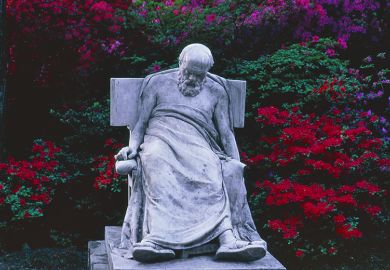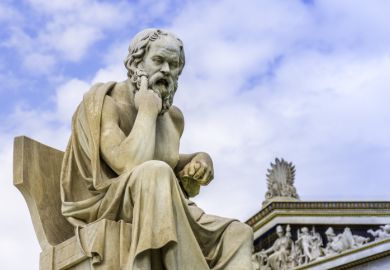"Nietzsche's philosophical biography is a story without end and will need to continue being written," says Rudiger Safranski near the end of his newly translated Nietzsche: A Philosophical Biography . And so sure enough, the book ends not with Nietzsche's descent into madness, nor even his death, but rather with a history of the further reception of his thought, and the suggestion that our fascination with the figure of "Nietzsche", and Nietzsche's self-proclaimed status as a "destiny" is neither exhausted nor perhaps exhaustible.
While much of this continuing fascination is due to the fact that Nietzsche's thought famously and defiantly resists exact or univocal interpretation, and gives each generation of scholarship its own opportunities for assessment and discovery, much of it is due, too, to Nietzsche's own apparent prescience concerning his posthumous reception and his deliberate construction of his own legend while alive and creative.
The interplay of text and life, of thought and its reception, is one of Nietzsche's richest and most elusive gifts. Rich because its many layers afford us considerable creative possibilities for interpretation; elusive, however, because its stratagems, silences and subterfuges can outwit us as much as they did on occasion outwit Nietzsche himself. So as Safranski suggests, Nietzsche's continuing reception is perhaps as much an aspect of his philosophical endowment as Nietzsche's own biography is, since Nietzsche himself can be said to have made it so, and moreover since we continue to make it so.
Safranski understands this interplay and its possibilities. His book is as much an attempt to read Nietzsche's thought through his life as it is an attempt to tell the story of his life as a succession of thoughts and works. Its success depends on the fusing of thought and life, on making the one as alive as the other. "Nietzsche was a laboratory of thinking," says the author, "and he never stopped interpreting himself."
And at its best, Safranski's Nietzsche does give us insight into some of the products of this laboratory (the will to power, eternal recurrence), while at other times, it gives us absorbing accounts of certain episodes of Nietzsche's life (the break with Wagner, correctly signalled as early as 1872-73 when the Nachlass was already voicing - and even hiding - significant concerns; the later rejection by Lou Salome), but in general, it affords us neither philosophy nor biography. The undoubtedly elegant prose can therefore - or perhaps this is a cause of the wider problems - come to seem rather empty, and sometimes curiously effete, suggesting that it might be better suited to the essay form or to the field of "cultural journalism" than that of "philosophical biography". It almost comes as little surprise, then, that at the end of the book, Safranski should invoke a painting by Caspar David Friedrich, The Monk at the Sea to offer us his lasting image of Nietzsche and his thought. That he should leave us with an image and a painter that are all too redolent of the cover of popular editions of Nietzsche's works or even of television documentaries is unfortunate but sadly telling.
If Safranski takes too much on trust Nietzsche's self-proclaimed status as solitary visionary and prophetic thinker whose thoughts were irruptions or sudden hammer blows, Gregory Moore's Nietzsche, Biology and Metaphor displays no such credulity. Showing a healthy scepticism towards both Nietzsche's views about his own "untimeliness" as well as certain received opinions that what the past hundred years of Nietzsche scholarship have enshrined might be seen - given the revisionist trends in Nietzsche scholarship of the past ten or so years - to situate Moore's work as being quite definitely of its own time, but it also addresses an area of Nietzsche studies that has for long called for such a detailed and well-informed work.
The major contention is that, far from being the product of an untimely and wholly original overturning of traditional values, Nietzschean themes of biology, health, race, sickness, decadence, symptomatology and so on were profoundly connected to 19th-century intellectual discourses on evolution and breeding. Darwin looms large here, both as a "moment" in cultural history and as a problem for Nietzsche, and Moore's success lies in uncovering the subtleties, both historical and intellectual, of Nietzsche's complex position on evolution, nature and the human, and his position in wider debates - of which Darwin was only a part - that Nietzsche characteristically borrowed from, adapted and sometimes subverted for his own purposes. This is an important addition to Nietzsche scholarship and does much to expose some of the received wisdom that has all too easily accrued to Nietzsche's thought over the past century and more.
It comes as a surprise that in one area Moore should all too readily follow the received wisdom himself, and that is in his discussion of art. Nietzsche does at times use the language of biology, particularly in his early work on tragedy and his identification of the Dionysian with the orgiastic, the cruel and the bodily, and with Nietzsche's late association of art with physiology. In the chapter of Moore's book that deals with the "Physiology of art", we hear only from the "early Nietzsche" or the "late Nietzsche". There is nothing in between, nothing of a period during which Nietzsche provides us with some of the richest insights into art in the history of philosophy, insights that have little or nothing to do with physiology or with the language of physiology, such as his identification of art with illusion and sometimes deception, the notion of the monological work of art - the work without "witnesses" - the apparent similarities between religious veneration and aesthetic veneration, his extraordinary account of the association of the artist with the ascetic and the saint and so on.
If Moore is suggesting the weaker thesis, as he sometimes does, that the language of biology informs Nietzsche's thought at crucial points across its various themes, then this, as he shows, is incontestable. If, however, we are to see a "reductive biologism" at work here, the stronger thesis he also at times argues for, then Nietzsche's complex position on art, the work of art and the artist controverts this directly. A fuller discussion of the place that metaphor plays in Nietzsche's thought, of metaphoricity in general as a question that Nietzsche himself addresses, might have made these distinctions clearer. Perhaps, though, this would have taken the book beyond its bounds and weakened its lessons to us. Although Nietzsche's thought is rooted in its time, it is never wholly circumscribed by its time; that is to say, it is both timely and defiant of its time.
Philip Pothen is communications manager, Joint Information Systems Committee, King's College London, and the author of the forthcoming Nietzsche and the Fate of Art .
Nietzsche, Biology and Metaphor
Author - Gregory Moore
ISBN - 0 521 81230 5
Publisher - Cambridge University Press
Price - £37.50
Pages - 228
Register to continue
Why register?
- Registration is free and only takes a moment
- Once registered, you can read 3 articles a month
- Sign up for our newsletter
Subscribe
Or subscribe for unlimited access to:
- Unlimited access to news, views, insights & reviews
- Digital editions
- Digital access to THE’s university and college rankings analysis
Already registered or a current subscriber?



